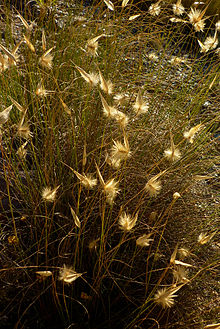Lygeum
| Lygeum | |
|---|---|

| |
| Lygeum spartum | |
| Scientific classification | |
| Kingdom: | Plantae |
| Clade: | Tracheophytes |
| Clade: | Angiosperms |
| Clade: | Monocots |
| Clade: | Commelinids |
| Order: | Poales |
| Family: | Poaceae |
| Clade: | BOP clade |
| Subfamily: | Pooideae |
| Supertribe: | Nardodae |
| Tribe: | Lygeeae J.Presl |
| Genus: | Lygeum Loefl. ex L. |
| Species: | L. spartum |
| Binomial name | |
| Lygeum spartum | |
| Synonyms[3] | |

MHNT
Lygeum is a genus of Mediterranean plants in the grass family.[4][5] It is placed in its own tribe Lygeeae, which is sister to Nardeae.[6]
The only known species is Lygeum spartum, commonly called esparto grass, cord grass[3][7] or albardine, which is distributed in arid areas around the Mediterranean Sea.[8] It is similar to Stipa tenacissima[9] and both species are used to produce a fiber product known as esparto or esparto grass.[10]
Description
Lygeum spartum is a rhizomatous hermaphroditic, perennial grass growing up to 75 centimetres (30 in) tall.[11] The rhizome and the base of the stem are scaly.[12] The leaves are threadlike but stiff[11] and tough, measuring up to 50 centimetres (20 in) long.[12] The inflorescence is made up of a few long-haired spikelets each up to 4.5 centimetres (1+3⁄4 in) long. They are wrapped in a lance-shaped bract called a spatheole.[11] This sheath is 3 to 9 centimetres (1+1⁄6 to 3+7⁄12 in) long and can have a sharp point.[12]
Distribution
Lygeum spartinum is native to southern Europe and North Africa, where its distribution includes Crete, Italy, Spain, Algeria, Egypt, Libya, Morocco, and Tunisia.[8][13] It may have been introduced to Kashmir.[14]
Habitat
Rocky sea shores, or on dry sandy or clay and often calcareous soil.[15]
Uses
Lygeum spartum fibres have high tensile strength and flexibility, and is used for making ropes, sandals, baskets, mats and other durable articles. They have also used in the manufacture of high quality paper.[16] It can also be used locally as a fodder for livestock and to stabilise sand dunes and rehabilitate salt soils, due to its tolerance of saline conditions.[17]
References
- ^ Palisot de Beauvois, Ambroise Marie François Joseph. 1812. Essai d'une Nouvelle Agrostographie 140
- ^ Tropicos, Spartum P. Beauv.
- ^ a b Kew World Checklist of Selected Plant Families
- ^ Linnaeus, Carl von. 1754. Genera Plantarum, ed. 5 27, (522).
- ^ Abdeddaim-Boughanmi, K. and M. Kaid-Harche. (2009). Structure, ultrastructure of the anther, pollen microsporogenesis and morphology of pollen grains of two populations of Lygeum spartum L. in Algeria. American Journal of Agricultural and Biological Sciences 4(3), 201-05.
- ^ Soreng, Robert J.; Peterson, Paul M.; Romaschenko, Konstantin; Davidse, Gerrit; Teisher, Jordan K.; Clark, Lynn G.; Barberá, Patricia; Gillespie, Lynn J.; Zuloaga, Fernando O. (2017). "A worldwide phylogenetic classification of the Poaceae (Gramineae) II: An update and a comparison of two 2015 classifications". Journal of Systematics and Evolution. 55 (4): 259–290. doi:10.1111/jse.12262. hdl:10261/240149. ISSN 1674-4918.

- ^ Altervista Flora Italiana, genere Lygeum, Sparto steppico, Esparto Grass
- ^ a b "Lygeum spartum". Germplasm Resources Information Network. Agricultural Research Service, United States Department of Agriculture. Retrieved 17 December 2017.
- ^ Garcı́a-Fuentes, A., et al. (2001). Review of communities of Lygeum spartum L. in the south-eastern Iberian Peninsula (western Mediterranean). Journal of Arid Environments 48(3), 323-39.
- ^ Watson, L. and M. J. Dallwitz. 1992 onwards. Lygeum. Archived 19 November 2007 at the Wayback Machine The Grass Genera of the World. DELTA – DEscription Language for TAxonomy. Version: 18 December 2012.
- ^ a b c Clayton, W. D., et al. (2006 onwards). Lygeum. GrassBase - The Online World Grass Flora.
- ^ a b c Lygeum spartum. Flora of Pakistan.
- ^ Lygeum spartum. Integrated Taxonomic Information System (ITIS).
- ^ "Lygeum spartum". Encyclopedia of Life. Retrieved 26 November 2016.
- ^ "Lygeum spartum - Loefl. ex L." Plants For A Future. Retrieved 26 November 2016.
- ^ "Esparto". Encyclopædia Britannica. Retrieved 26 November 2016.
- ^ Bouzid Nedjimi (2009). "Salt tolerance strategies of Lygeum spartum L.: A new fodder crop for Algerian saline steppes". Flora - Morphology, Distribution, Functional Ecology of Plants. 204 (10): 747–754. Bibcode:2009FMDFE.204..747N. doi:10.1016/j.flora.2008.11.004.
